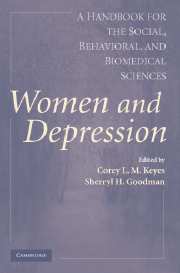Book contents
- Frontmatter
- Contents
- List of Contributors
- Foreword
- Preface
- PART I NOSOLOGY, MEASUREMENT, AND THE EPIDEMIOLOGY OF WOMEN AND DEPRESSION
- PART II BIOLOGICAL, DEVELOPMENTAL, AND AGING MODELS OF RISK
- PART III COGNITIVE, EMOTIONAL, AND INTERPERSONAL MODELS OF RISK
- PART IV SOCIAL, POLITICAL, AND ECONOMIC MODELS OF RISK
- 12 Social Suffering, Gender, and Women's Depression
- 13 Women, Work, and Depression
- 14 Culture, Race/Ethnicity, and Depression
- 15 Trauma and Depression
- 16 Public Health Approach to Depression and Women
- PART V SYSTEMS AND PROCESSES OF TREATMENT, PREVENTION, AND POLICY
- Author Index
- Subject Index
- References
12 - Social Suffering, Gender, and Women's Depression
Published online by Cambridge University Press: 05 June 2012
- Frontmatter
- Contents
- List of Contributors
- Foreword
- Preface
- PART I NOSOLOGY, MEASUREMENT, AND THE EPIDEMIOLOGY OF WOMEN AND DEPRESSION
- PART II BIOLOGICAL, DEVELOPMENTAL, AND AGING MODELS OF RISK
- PART III COGNITIVE, EMOTIONAL, AND INTERPERSONAL MODELS OF RISK
- PART IV SOCIAL, POLITICAL, AND ECONOMIC MODELS OF RISK
- 12 Social Suffering, Gender, and Women's Depression
- 13 Women, Work, and Depression
- 14 Culture, Race/Ethnicity, and Depression
- 15 Trauma and Depression
- 16 Public Health Approach to Depression and Women
- PART V SYSTEMS AND PROCESSES OF TREATMENT, PREVENTION, AND POLICY
- Author Index
- Subject Index
- References
Summary
There is nothing the matter with one but a temporary nervous depression — a slight hysterical tendency — what is one to do? (p. 10)
I get unreasonably angry with John sometimes. I'm sure I never used to be so sensitive. I think it is due to this nervous condition.
But John says that if I feel so I shall neglect proper self-control; so I take pains to control myself — before him, at least, and that makes me very tired. (p. 11)
But these nervous troubles are dreadfully depressing.
John does not know how much I really suffer. He knows there is no reason to suffer, and that satisfies him. (p. 14)
I don't feel as if it was worth while to turn my hand over for anything, and I'm getting dreadfully fretful and querulous.
I cry at nothing, and cry most of the time. (p. 19)
Charlotte Perkins Gilman, 1899/1973These lines are from The Yellow Wallpaper, a short story composed by Charlotte Perkins Gilman at the turn of the 19th century. Gilman was no stranger to social suffering. The story was, as Elaine Hedges puts it, “wrenched out of her own life” (1973, p. 37). Gilman was an outspoken leader and theorist of the feminist movement of the late 1800s, regarded by some as its leading American intellectual. Gilman's focus was primarily on women's economic dependency in marriage, which she regarded as the linchpin of female subordination (Gilman, 1898).
- Type
- Chapter
- Information
- Women and DepressionA Handbook for the Social, Behavioral, and Biomedical Sciences, pp. 283 - 308Publisher: Cambridge University PressPrint publication year: 2006
References
- 17
- Cited by



